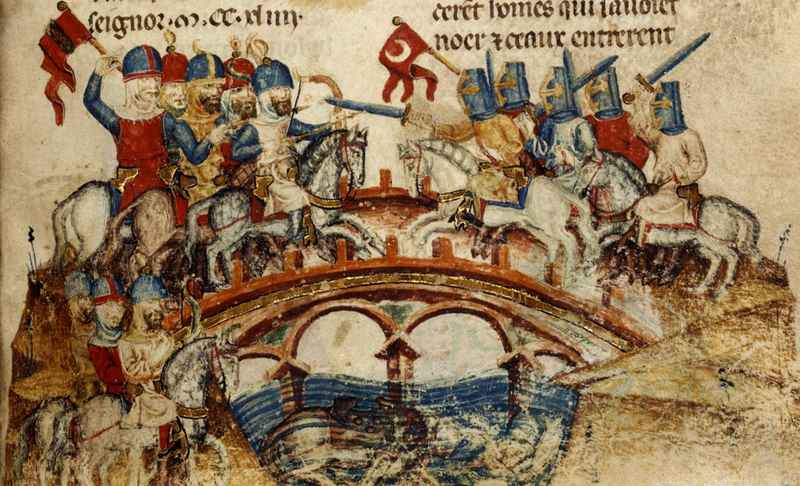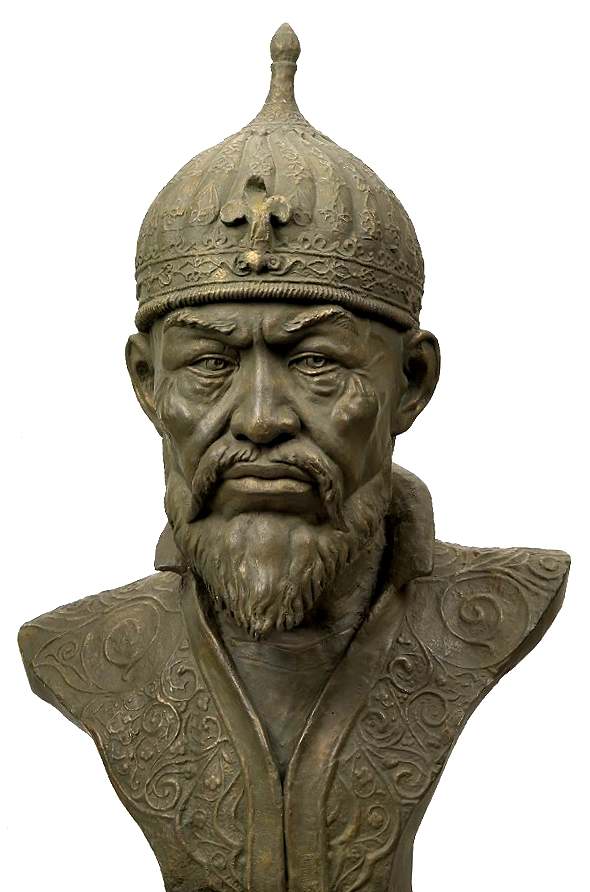Golden Horde
The Golden Horde, also known as Kipchak Khanate or the Ulus of Jochi, was a Mongol state established in parts of present-day Russia, Ukraine, and Kazakhstan.
Prior to his death in 1227 CE, Genghis Khan divided the Mongol Empire and assigned to his four sons in the event of death. His eldest son, Jochi, died six months before Genghis Khan. Jochi's portion, the westernmost lands occupied by the Mongols, which included what is today southern Russia and Kazakhstan, was divided between Jochi's sons: (1) Batu Khan, leader of the Blue Horde at the west, and (2) Orda Khan, leader of the White Horde at the east. Batu subsequently established control over Orda's territorial endowment. Below is a portrait of Batu:

For easy understanding of the location of the wars below, a map of present-day Europe is provided:

When Batu received the Blue Horde, the western border of his territories was at the Caspian Sea. In 1235 CE Batu pushed westwards. He sent one army to push from the Caspian Sea to the Black Sea. By 1238 the army conquered areas that correspond to present-day Azerbaijan, Georgia, and Armenia. He sent another army marching through present-day Kazakhstan to eastern Europe. In the winter of 1237-1238 CE, Batu's army attached the Russian principalities. The city of Ryazan (close to Moscow) was besieged. The army started to attack other cities. The Russian princes, beset by long-standing rivalries, could not work together even in this great emergency. Next came Moscow's turn to be torched (at that time it was a medium sized city and not the capitol). Then Suzdal in 1238 CE, and finally Vladimir, about 120 miles from Moscow and was the fortified capital, was besieged. Grand Duke Yuri II fled the city to gather his army together, leaving his wife and sons to face the attack. When Grand Duke Yuri returned with his army to the city, it had already fallen and its famous cathedral torched. The Duke's army was defeated and he himself was killed at the battle of Sit river. Below is a painting of the fighting at Suzdal:

The Mongol army also moved into Ukraine in 1239 CE and captured Kiev, its capitol, after a brief siege in December 1240 CE. The inhabitants of Kiev were put to the sword just as they had been elsewhere.
From Kiev the army moved through Galicia and Podolia (both were historic regions in Ukraine) and on to Eastern Europe. The army marched through Bohemia and Moravia (in present-day Czech Republic and Slovakia) to attack Poland. In Poland, Henry the Pious, the Duke of Silesia commanded a large army of Poles and Germans, amongst other. In April 1241. he was defeated and killed and his head paraded on a spike.
A multi-pronged attack was launched in 1241 CE to attack Hungary. Hungary was selected as a primary target because of its grasslands, which the Mongols considered a perfect base for their horses from where they could then attack western Europe. One group of Mongol army moved through Moravia in the north and three more going through and around the Carpathian mountains in the west. The westernmost Mongol army went deep into Moldavia and Wallachia (in present-day Romania) and then turned to attack Hungary from the south. A Hungarian army led by their king Bela IV mobilized to meet the invaders in open country. However, Bela's army was roundly defeated on 10-11 April at the Battle of Mohi (present-day Muhi, Hungary). Below is a 13th century painting of the Battle of Mohi:

Batu Khan did not advance pass Hungary. There were speculations on the reason. One possibility is that the second Great Khan of Mongolia, Ogedei Khan, died in December 1241. Recently, researchers studied the climate of Hungary in 1241-1242 CE and determined that the unusually cold and wet condition in early 1242 contributed to Batu Khan's decision to abandon Hungary and returned to Russia (see a research paper below). At this time, we don't know the real reason.
Batu Khan died in 1256. His successor made some minor territorial advances, such as attacking Prussia (present-day Germany) in 1250 and Lithuania in 1258, but generally focused on domestic issues. Although there were turmoil, the Europeans lived quietly under Mongol rule. The Mongols took regular census counts and required regular tax payments, but otherwise left the people to their own devices so long as they did not try to rebel. Improved trade and communications routes made the flow of goods and information easier than ever before.
In 1340, a new wave of deadly invaders swept in from Asia. This time, it was fleas carrying the Black Death. The loss of population hit the Golden Horde hard. By 1359, the Mongols had fallen back into dynastic squabbles, with as many as four separate claimants vying for the khanate simultaneously. Meanwhile, various Slavic and Tatar city-states and factions began to rise up again.
At the south, a new empire was found by a Turco-Mongol warrior named Timur (who claimed to be a descendant of Genghis Khan). He dealt the tottering Golden Horde a crushing blow in 1395 through 1396, when he destroyed their army, looted their cities and appointed his own khan. The Golden Horde stumbled on until 1480, but it was never the great power it had been after Timur's invasion. In that year, Ivan III of Russia drove the Golden Horde from Moscow and established the nation of Russia. Remnants of the Horde attacked the Grand Duchy of Lithuania and the Kingdom of Poland between 1487 and 1491 but were soundly thrashed. Below is a statue of the Timur:

The final blow came in 1502 when the Crimean Khanate sacked the Golden Horde's capital at Sarai. After 250 years, the Golden Horde disappeared from the world stage.
This is the research paper on the climate of Hungary:
Climatic and environmental aspects of the Mongol withdrawal from Hungary in 1242 CE
